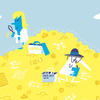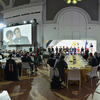You are here
"Our objective: 100% publications in open access"

What are your plans for expanding open science principles and practices at the CNRS?
Alain Schuhl: Our action covers four areas: open access for scientific publications, sharing scientific data, developing and promoting data mining tools for scientific content, and finally individual assessment for researchers. These are the four pillars that we expect will help advance open science at the CNRS. Our roadmap is based on these points, as is that of the National Plan for Open Science. At present, only 50% of the scientific publications involving CNRS researchers are freely accessible. Our objective is to quickly reach 100%, ideally by late 2020. We will use our utmost endeavours to achieve this, and equip researchers with the best resources.
Will the HAL open archive eventually contain all of the CNRS’s scientific publications?
A. S.: We certainly hope so, which is why we set up a new rule in 2019 to encourage researchers to self-archive: only publications submitted to HAL will be listed in the annual activity reports of CNRS scientists. But to be honest, this will not be enough. We must continue to mobilise researchers, for example by facilitating these deposits via HAL as much as possible. To do so, we will expand the team at the Centre for Direct Scientific Communication, which is in charge of HAL, in an effort to improve both the website's usability and links to other open archives, such as arXiv. It is essential that in the future, the archiving of a publication on another open site be automatically reflected on HAL, and vice versa. What we want is for researchers to fully embrace it. A HAL-CNRS portal was created for publications by CNRS researchers, and €650,000 were allocated to HAL in 2019 to support these deposits.
Do you have the same objective for data sharing?
A. S.: This component is less mature than that of scientific publications. For now we are chiefly seeking to encourage reflection, and to increase awareness that this sharing will be beneficial for everyone. We will of course continue to support the development of the Data Management Plan for Optimized Sharing and Interoperability of Research Data (Opidor). In addition to issues related to data formats and how to select the relevant information to archive, we will also have to discuss the best scale—local, regional, or national—for its physical storage. We also hope that this question will be coupled with that of data and text mining.1 Researchers must eventually be able to easily extract relevant facts—and even new knowledge—from these vast sets of scientific material.
What changes will there be to personal evaluation criteria for researchers?
A. S.: It is clear that these profound changes in the logic of publication will not occur without extensive modifications to how researchers are evaluated. We are looking into this matter in close collaboration with each branch of the National Committee for Scientific Research, in charge of assessing scientists and the way they conduct their work. We believe that the quality of research and results should prevail over the quality of the journal in which they are published. In the UK, some universities ask their researchers to submit a selection of only five publications that they believe to be their most emblematic. This is an avenue that is worth exploring and has the advantage of basing evaluation on a reasonable selection of open access articles rather than on an exhaustive, non-selective list.
- 1. Text mining is a series of techniques relating to artificial intelligence that combines the fields of linguistics, semantics and language, statistics, and computer science. These techniques can extract and recreate information from a body of texts (classification, analysis, trends, etc.)








